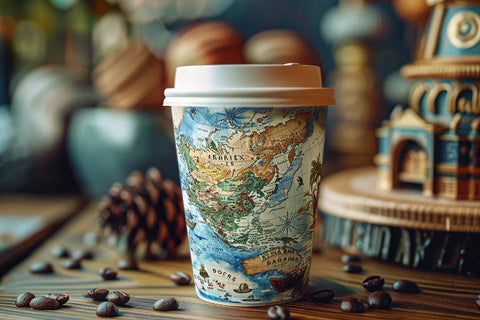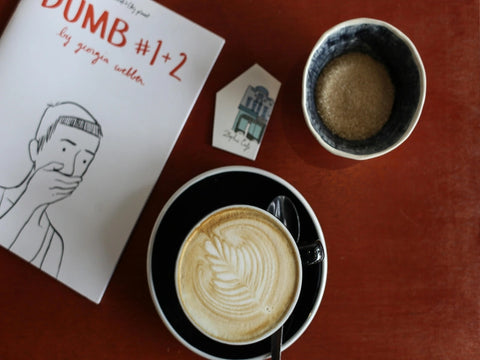Introduction to Coffee Books:
Coffee has become a staple in the daily lives of many women, and with its rich history, intricate art, scientific complexities, global culture, and impact on women, it has inspired a multitude of books. These books not only educate us on the history, making, and science behind coffee but also highlight women's significant role in this industry.
The History of Coffee:
Coffee has been a part of human civilization for centuries, with its origins dating back to ancient Ethiopia. Over time, it has evolved and spread to different parts of the world, creating a rich cultural heritage. A prominent name in the coffee industry, Anette Moldvaer, explores these origins in her book "Coffee: From Bean to Barista," while "The World Atlas of Coffee" by James Hoffmann delves into the global history of coffee.
Read: The Great Bean Mystery Unraveling Coffees Secret History
The Art of Coffee Making:
The art of making a perfect cup of coffee is a skill that requires knowledge and practice. There are various brewing methods, each with its unique flavor profile, and "The Blue Bottle Craft of Coffee" by James Freeman explores these methods in detail. "The Barista's Handbook" by Scott Rao delves into the technicalities of coffee making and how to achieve the perfect cup.
The Science Behind Coffee:
Coffee is a complex beverage with over 800 chemical compounds, and its most well-known component, caffeine, has significant effects on the body. "Coffee: A Comprehensive Guide to the Bean, the Beverage, and the Industry" by Robert W. Thurston is a comprehensive resource for understanding the science behind coffee. "Caffeinated: How Our Daily Habit Helps, Hurts, and Hooks Us" by Murray Carpenter dives into the effects of caffeine and its role in our society.
Coffee Culture Around the World:
Coffee has a profound impact on cultures around the world, with each country having its unique way of enjoying this beverage. "The World Atlas of Coffee" by James Hoffmann and "Coffee Life in Japan" by Merry White explore the different coffee cultures in different countries and how this drink brings people together.
Coffee and Women:
Coffee has played a significant role in women's history, from being a symbol of liberation during the suffrage movement to providing economic opportunities for women in the industry. "God in a Cup: The Obsessive Quest for the Perfect Coffee" by Michaele Weissman and "What Women Really Want: Coffee and Chocolate" by Phillip S. Hart highlight the crucial role women have played in the coffee industry.
The Best Coffee Books for Women:
- "Women in Coffee: Stories from Around the World" by Anette Moldvaer
- "The Women's Guide to Coffee: A Manifesto" by Andrea Illy
- "A History of the World in 6 Glasses" by Tom Standage
- "Uncommon Grounds: The History of Coffee and How It Transformed Our World" by Mark Pendergrast
- "The Monk of Mokha" by Dave Eggers
These books provide a comprehensive understanding of the world of coffee and its impact on women, making them a must-read for every coffee-loving woman.
Key Takeaways:
The History of Coffee
The history of coffee dates back to the 15th century, originating in the Ethiopian region of Kaffa. From there, coffee spread to the Arabian Peninsula and eventually reached Europe. The first coffeehouse opened in Constantinople in 1475, and by the 17th century, coffeehouses had become popular centers for social interaction and communication.
In the 17th century, Dorothy Jones, an avid coffee enthusiast, opened the first coffeehouse for women in London, providing a space for intellectual discussions and empowerment.
What are the Origins of Coffee?
The origins of coffee can be traced back to ancient times, according to the legend of Kaldi, an Ethiopian goatherd who discovered the stimulating effects of the beverage. Historically, coffee cultivation began in the Arabian Peninsula, specifically in Yemen, where it was first utilized for its energizing properties. From there, it gradually spread to other parts of the world.
The coffee plant, known as Coffea, produces beans that have become a valuable commodity globally, influencing cultures and economies.
How Has Coffee Evolved Over the Centuries?
- Origins in Ethiopia: Coffee's journey began in the 9th century in Ethiopia, where it was discovered by a goat herder who noticed the energizing effect of coffee beans on his goats.
- Spread to Arabia: By the 15th century, coffee had spread to the Arabian Peninsula, where the first coffeehouses emerged, becoming centers for social and intellectual interaction.
- Global Expansion: Coffee continued its evolution, with cultivation spreading to regions like India, Indonesia, and the Americas, leading to the development of various coffee species and flavors.
Pro-tip: Understanding the historical evolution of coffee can deepen appreciation for its rich cultural significance and diverse flavors. How Has Coffee Evolved Over the Centuries?
The Art of Coffee Making

- Gather fresh, high-quality coffee beans.
- Grind the beans to the appropriate coarseness for your chosen brewing method.
- Measure the coffee and water precisely to achieve the perfect coffee-to-water ratio.
- Use clean, good-quality water just off the boil for brewing.
Pro-tip: Experiment with different brewing methods and ratios to find your perfect cup of coffee. The Art of Coffee Making lies in the details, so don't be afraid to tweak and adjust until you find your ideal brew.
What are the Different Brewing Methods?
Exploring the world of coffee involves understanding the different brewing methods such as pour-over, French press, cold brew, Aeropress, and espresso. Each method offers a unique way to extract flavors and aromas from coffee beans, catering to diverse preferences.
For a rich and full-bodied taste, consider trying the French press, while for a quick and intense coffee experience, the espresso method might be the perfect fit.
How to Make the Perfect Cup of Coffee?
- To make the perfect cup of coffee, start with fresh, high-quality coffee beans.
- Grind the beans just before brewing.
- Use the right coffee-to-water ratio for your chosen brewing method.
- Ensure the water is at the optimal temperature, around 195-205°F.
- Pour the water evenly over the coffee grounds, allowing it to bloom.
- Stir the coffee gently for even extraction.
- Let the coffee brew for the appropriate time, then enjoy your perfect cup of coffee.
In the 15th century, coffee was discovered by a goatherd in Ethiopia. The drink's popularity quickly spread, leading to the development of various brewing methods and the rise of coffee houses, shaping coffee culture as we know it today.
The Science Behind Coffee
Understanding the science behind coffee involves delving into its chemical composition, brewing methods, and physiological effects. The chemical compounds, including caffeine and chlorogenic acids, play a role in creating the aroma and flavor of coffee. Different brewing methods, such as espresso and pour-over, impact the extraction of flavors. On a physiological level, caffeine affects the central nervous system, increasing alertness and decreasing fatigue. By exploring these various aspects, one can gain a comprehensive understanding of the beloved beverage known as coffee.
What are the Chemical Components of Coffee?
The chemical components of coffee include caffeine, chlorogenic acids, trigonelline, caffeol, and diterpenes. These compounds contribute to the taste, aroma, and physiological effects of coffee. Caffeine, for instance, is responsible for the stimulating effects, while chlorogenic acids provide antioxidant properties.
Did you know that caffeine, a key component in coffee, is also found in various other plants such as tea leaves, cacao beans, and kola nuts?
How Does Caffeine Affect the Body?
- Caffeine, when ingested, quickly travels to the brain and blocks the inhibitory neurotransmitter adenosine, leading to increased neural firing and the release of adrenaline.
- This stimulation results in improved mood, increased alertness, enhanced cognitive function, and a temporary boost in physical performance.
- However, excessive consumption can cause restlessness, anxiety, or disrupted sleep patterns.
Did you know that caffeine's half-life can range from 3 to 7 hours, meaning it takes this amount of time for your body to eliminate half of the caffeine you consumed?
Coffee Culture Around the World

- Italy: Experience the traditional leisurely pace of enjoying espresso in cozy cafes.
- Ethiopia: Explore the birthplace of coffee and witness the unique coffee ceremony.
- Japan: Embrace the meticulous art of pour-over coffee and savor the serene coffee culture.
- Australia: Indulge in the thriving coffee scene with a preference for flat whites and robust flavors.
In Turkey, coffee fortune-telling is a cherished tradition where patterns formed by coffee grounds are interpreted to predict one's future.
Read: Around the World in 80 Coffees A Global Tasting Journey
What are the Different Coffee Cultures in Different Countries?
Different countries have unique coffee cultures, reflecting diverse traditions and preferences.
In Ethiopia, coffee ceremonies are a significant part of social gatherings, emphasizing the importance of community.
Italy embraces the espresso culture, with small, strong shots of coffee being a way of life.
In Vietnam, the popular Vietnamese coffee is a blend of strong coffee and sweetened condensed milk, embodying the country's creativity in coffee preparation.
Did you know that Finland is the top consumer of coffee per capita globally?
How Does Coffee Bring People Together?
- Coffee creates social connections: Coffee shops serve as meeting places, fostering conversations and bonding among people from diverse backgrounds.
- Community events: Coffee-related events, like tastings or workshops, provide opportunities for individuals to engage, share experiences, and build relationships.
- Cultural rituals: Coffee rituals, such as coffee ceremonies in Ethiopia, bring communities together, promoting unity and social cohesion.
Coffee and Women

When examining the connection between coffee and women, it becomes clear that women have played crucial roles throughout the history and culture of coffee. From growing coffee beans to innovating new brewing methods, women have had a significant impact on the coffee industry. Additionally, there are now many efforts dedicated to empowering women in coffee-growing areas, promoting gender equality, and offering assistance to female coffee business owners.
Read: The Role of Coffee in Women's Health Myths and Facts
How Has Coffee Played a Role in Women's History?
- Women's socialization: Throughout history, coffeehouses have provided women with rare opportunities to socialize outside of their homes.
- Entrepreneurship: Women have been actively involved in coffee businesses, including opening coffee shops and roasteries.
- Economic empowerment: In certain cultures, the trade and cultivation of coffee have allowed women to achieve financial independence.
- Advocacy: Women's participation in coffee production has also led to advocacy for fair labor practices and gender equality.
What are the Challenges and Opportunities for Women in the Coffee Industry?
Women in the coffee industry face numerous challenges, including gender disparities in access to resources, land ownership, and leadership roles. However, there are opportunities available through female-focused coffee initiatives, such as 'Women in Coffee' programs, which aim to empower women through education and advocacy.
Some suggestions to support women in the coffee industry include:
- supporting women-owned coffee businesses
- advocating for gender-inclusive policies
- promoting awareness of the challenges and triumphs faced by women in the industry
The Best Coffee Books for Women

For all the coffee-loving women out there, this is the ultimate reading list for you. These books are not just about coffee, they also highlight the stories and experiences of women in the coffee industry. From inspiring memoirs to historical accounts, these books will satisfy your caffeine cravings and leave you feeling empowered. Let's take a closer look at each book and see what makes them the best coffee books for women.
1. "Women in Coffee: Stories from Around the World" by Anette Moldvaer
Anette Moldvaer's book, "Women in Coffee: Stories from Around the World," delves into the diverse experiences of women in the global coffee industry. Through her work, Moldvaer sheds light on the roles, challenges, and contributions of women, highlighting their impact on the coffee world. Her book offers an insightful and empowering perspective, showcasing the crucial role of women in shaping the coffee landscape.
2. "The Women's Guide to Coffee: A Manifesto" by Andrea Illy
"The Women's Guide to Coffee: A Manifesto" by Andrea Illy provides a comprehensive insight into the world of coffee from a female perspective. It delves into the historical and cultural significance of coffee, while also highlighting the important role of women in the coffee industry. Illy's book presents an empowering narrative, celebrating the influence of women in this field and their unique experiences with coffee.
If you enjoyed Andrea Illy's book, you may also appreciate:
- "Uncommon Grounds: The History of Coffee and How It Transformed Our World" by Mark Pendergrast
- "The Monk of Mokha" by Dave Eggers
for their intriguing exploration of coffee's impact.
3. "A History of the World in 6 Glasses" by Tom Standage
'A History of the World in 6 Glasses' by Tom Standage is a captivating exploration of the impact of six beverages on history, including coffee. The book delves into the significance of coffee in shaping social, political, and economic landscapes, offering a fascinating perspective on the profound influence of this beloved beverage throughout the ages.
4. "Uncommon Grounds: The History of Coffee and How It Transformed Our World" by Mark Pendergrast
Mark Pendergrast's 'Uncommon Grounds: The History of Coffee and How It Transformed Our World' offers a captivating journey through the historical, cultural, and economic impact of coffee. The book delves into the evolution of coffee from a simple Ethiopian plant to a global commodity, exploring its influence on politics, social structures, and trade. Pendergrast skillfully weaves together narratives, anecdotes, and meticulously researched facts, making it a must-read for any coffee enthusiast seeking a deeper understanding of the beverage's profound significance.
5. "The Monk of Mokha" by Dave Eggers
In 'The Monk of Mokha' by Dave Eggers, the story follows the journey of a Yemeni-American as he strives to revive Yemen's coffee industry, providing a glimpse into the culture, history, and intricacies of the coffee trade in Yemen.
Frequently Asked Questions
1. What is the specialty coffee community and how can I learn more about it?
The specialty coffee community is a group of coffee enthusiasts, baristas, roasters, and others in the industry who are passionate about specialty coffee. To learn more, you can ask your local barista about the coffee they are using or read books specifically about specialty coffee, such as "Left Coast Roast" by Hanna Neuschwander.
2. What are some interesting facts I can learn about coffee from books?
Books about coffee cover a variety of topics, from origin locations to brewing techniques. Some interesting facts you can learn include the art deco history of coffee, how boiling water affects the taste of coffee, and the role of fair trade in the industry.
3. What are some popular coffee books that are must-reads for every coffee lover?
Some popular coffee books include "The World Atlas of Coffee" by James Hoffman, "The Blue Bottle Craft of Coffee" by James Freeman, "Uncommon Grounds" by Mark Pendergrast, and "The Coffee Dictionary" by Maxwell Colonna-Dashwood. These books offer insight into the industry, tips for brewing the perfect cup, and interesting facts about coffee.
4. Are there any books about coffee and writing?
Yes, there are books that explore the connection between coffee and writing, such as "Coffee and Writing" which highlights how many writers find inspiration and productivity in coffee shops. However, the idea of writing in a coffee shop is often romanticized and can be distracting in reality.
5. What are coffee table books and why are they popular among coffee lovers?
Coffee table books are large, attractive books that are primarily for aesthetics and are often used as decor on coffee tables. They are not necessarily about coffee, but many coffee lovers use them for inspiration and decoration. Popular coffee table books include "Inside Knowledge" by Square Mile Coffee Roasters and "Vancouver BC: A Road Trip Adventure" by Google Search.
6. What are some must-read books for those interested in specialty coffee?
For those specifically interested in specialty coffee, there are seven must-read books. These include "Left Coast Roast" by Hanna Neuschwander, "The World Atlas of Coffee" by James Hoffman, and "The Blue Bottle Craft of Coffee" by James Freeman. These books offer inside knowledge from experts in the industry and cover topics such as origin locations, brew methods, and coffee terms.


